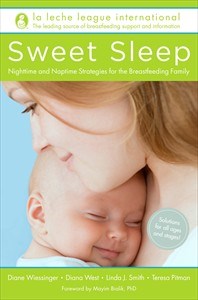
The cover of the book "Sweet Sleep" by La Leche League International is shown. THE CANADIAN PRESS/HO, Penguin Random House Canada
July 23, 2014 - 9:46 AM
TORONTO - Leaders of a support group for breastfeeding mothers have advice for sleep-deprived new moms in need a few extra zzz's: consider sharing your bed with your baby.
La Leche League International has produced "Sweet Sleep" (Ballantine Books) which outlines naptime and nighttime strategies for breastfeeding families.
While the four co-authors set out to discuss a variety of sleeping arrangements, the book mainly focuses on the benefits of bed-sharing.
"We thought we would have different chapters on how to manage when your baby's in a room down the hall and different kinds of situations. But as we started to look at the research we found a number of things," said Teresa Pitman, the Canadian co-author who has written several books on breastfeeding and has been a La Leche League leader for about 35 years.
"One of the things was ... the vast majority of breastfeeding mothers will bring their baby into the bed and sleep with them sometimes, and really, when you think about it, it's almost inevitable.
"Most breastfed babies need to feed during the night for various reasons, and so the mothers needs to be able to feed them; and when you're tired, you tend to fall asleep. The hormones when you breastfeed the baby relax you and make it more likely that you're going to fall asleep when you're nursing."
Pitman said research also shows that breastfeeding mothers who bed-share get more sleep than any other group of mothers, and that the sleeping arrangement seems to support and encourage them to keep breastfeeding.
Based on extensive research, the authors developed the Safe Sleep Seven aimed at addressing the risks of Sudden Infant Death Syndrome and suffocation. The seven conditions include ensuring that mothers are non-smokers, sober and breastfeeding babies who are full-term and healthy, kept on their backs when not nursing and unswaddled and lightly dressed.
Mother and child must also lie together on a safe surface, with the bed clear of unused pillows, stuffed toys, heavy covers and comforters and anything that dangles or tangles like cords, strings or elastics. Smothering risks should also be avoided like sofas and recliners, softness or sagging that rolls babies against their mothers or keeps them from lifting their heads free, and spaces between the mattress, headboard side rails or wall where a baby could get stuck.
"There isn't a way to eliminate all risk of everything ever in anything you do, but this seems to eliminate all of the significant risk factors," Pitman said.
The Guelph, Ont., resident found the sleeping arrangement particularly beneficial after her son, Dan, was born, with her then 2 1/2-year-old daughter Lisa experiencing a period of adjustment with the new baby's arrival.
"I can remember quite vividly sleeping between the two of them and nursing the baby and she would snuggle up against my back and say: 'I love you, Mommy,'" recalled the mother of four and grandmother of six. "It was a lovely way to give her that extra contact with me that she really needed right then, and I could still very comfortably be nursing my new baby who also needed me at the same time."
In its position statement on safe sleeping environments for infants and children, the Canadian Paediatric Society acknowledged that the practice of bed-sharing "is not uncommon in our society and remains the routine sleeping arrangement in most of the world’s non-industrialized cultures."
"Mothers in non-Western cultures who traditionally sleep with their children say that they do so to monitor them, keep them safe, facilitate breastfeeding and, simply, be near them," a portion of the statement reads. "The North American emphasis has traditionally been on having children sleep in their own beds, which is thought to play an important role in the child's ability to learn to separate from the parent and to see himself/herself as an independent individual."
The CPS recommends that for the first year of life, the safest place for babies to sleep is in their own crib, and in the parent's room for the first six months. The association goes on to add that room-sharing is protective against SIDS "and that this type of sleeping arrangement is a safer alternative to bed-sharing."
Pitman acknowledged that for some mothers, bed-sharing is probably not a great idea. But those who are on the fence should consider trying the sleeping arrangement.
"If you're sort of undecided because you feel like 'Oh, the baby's going to keep me awake, my sleep will be disturbed by the baby,' sometimes mothers find when they try it that that's not what happens, that they do sleep well with their baby close to them.
"Some of them find that they actually don't sleep as well when the baby's further away because they're listening for them. So sometimes, it's the kind of thing that you need to try to really know how it's going to go for you.
"Even if you intend not to bed-share, it's very helpful to prepare for the time when it may happen."
— Follow @lauren_larose on Twitter.
___
Online:
www.llli.org
News from © The Canadian Press, 2014